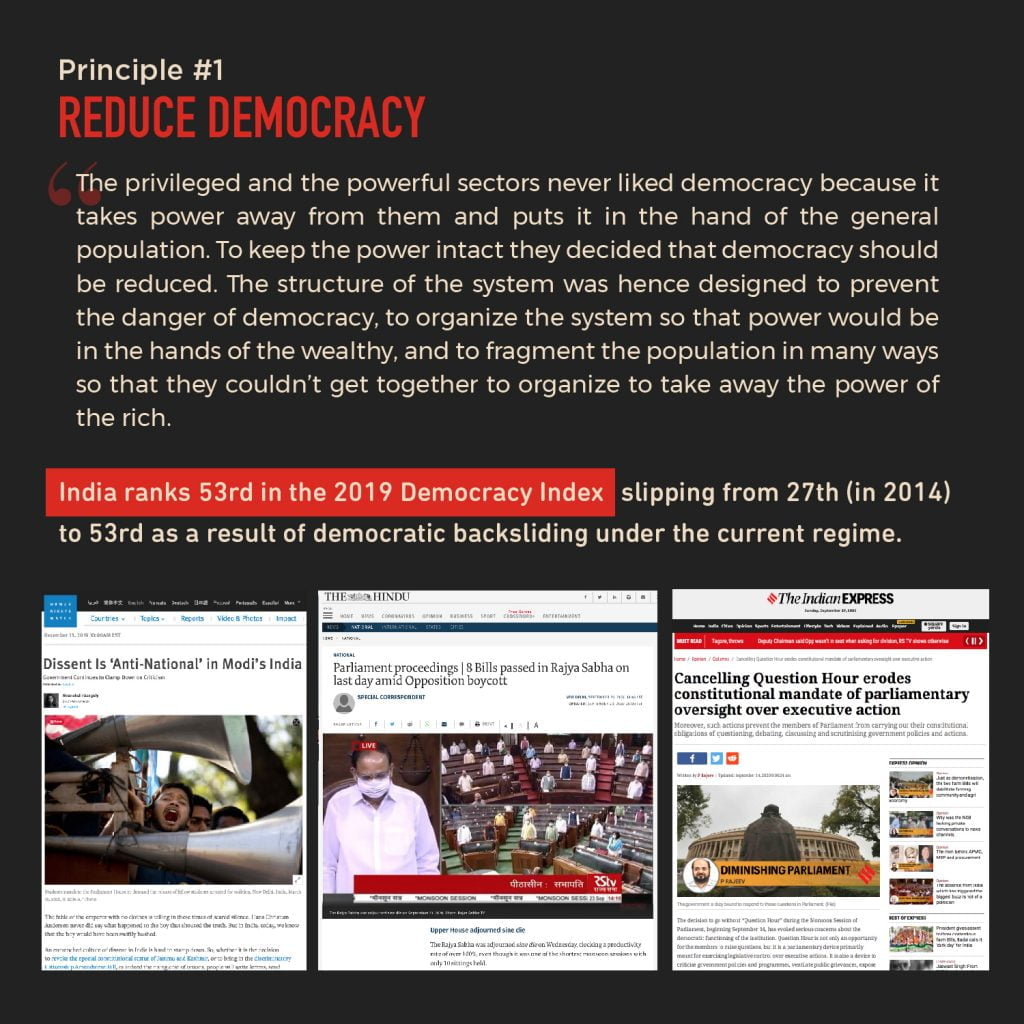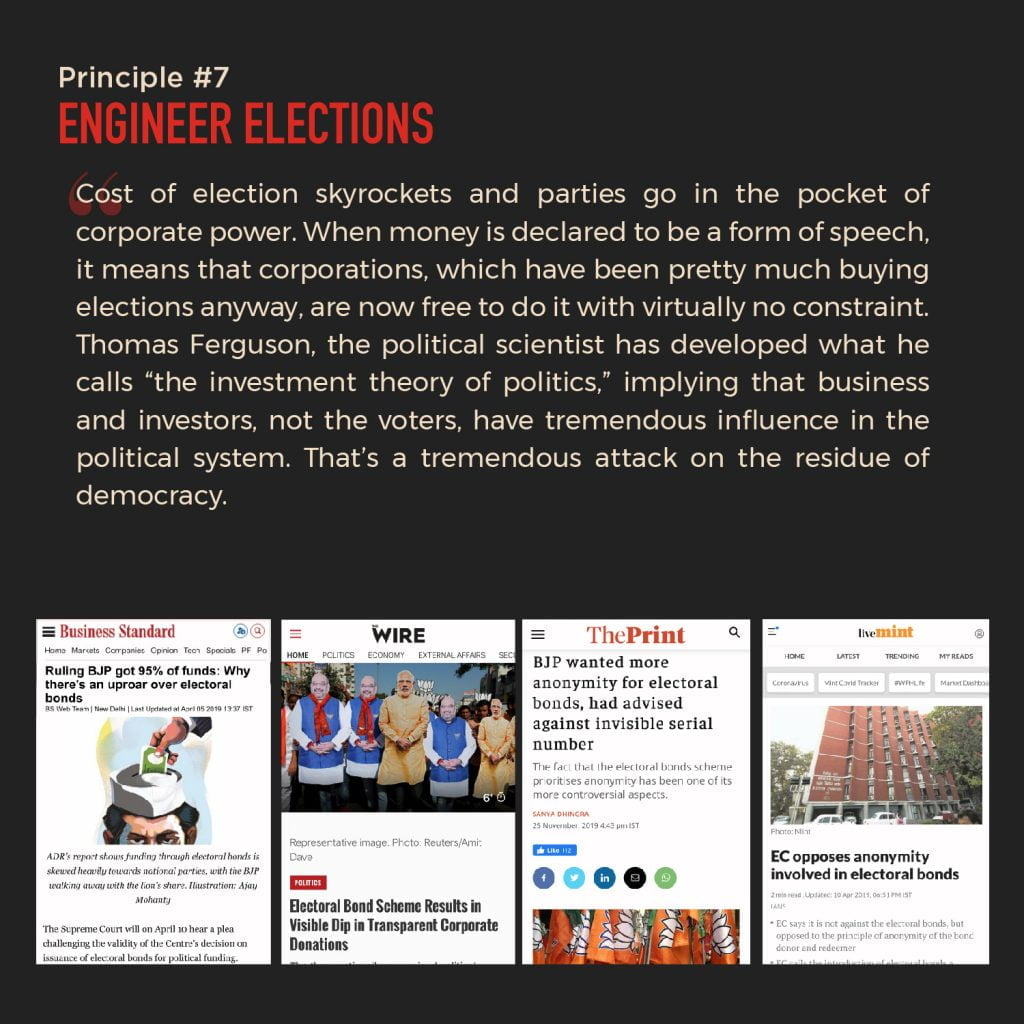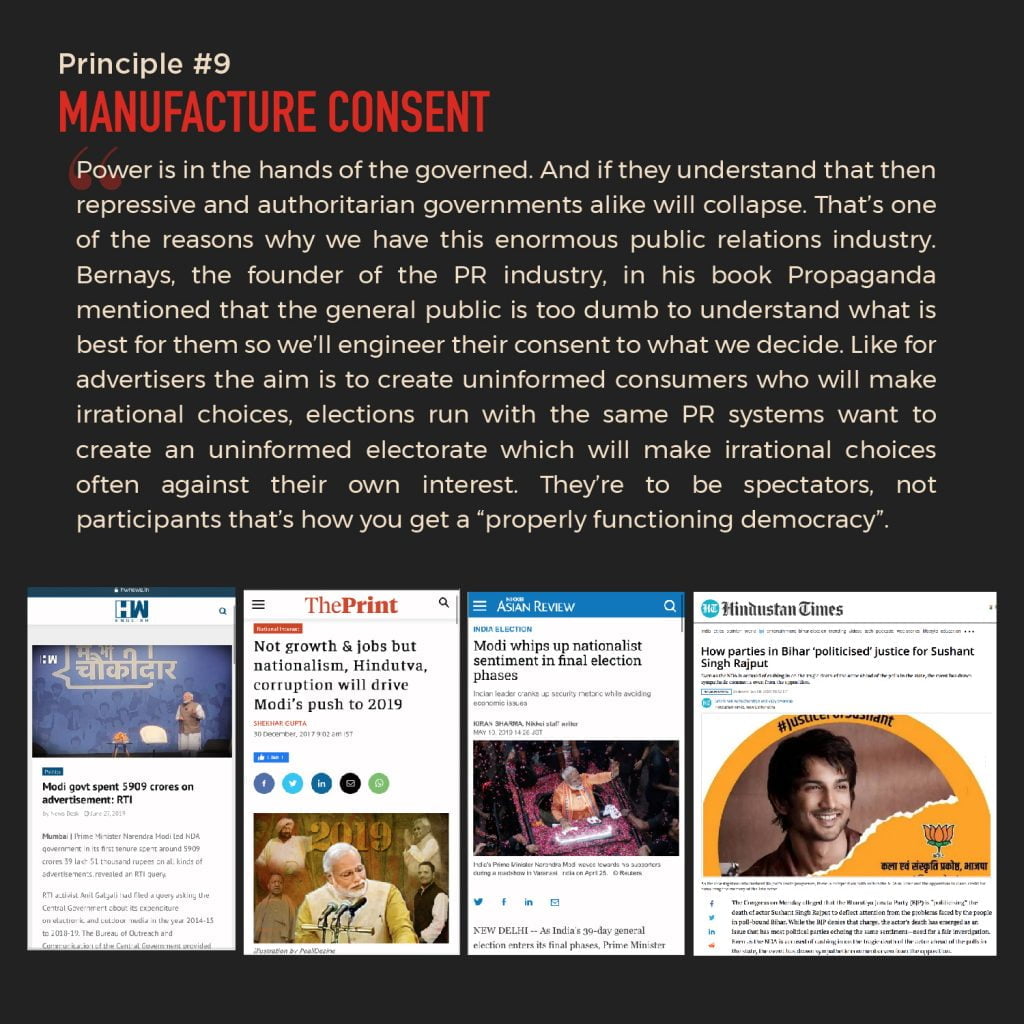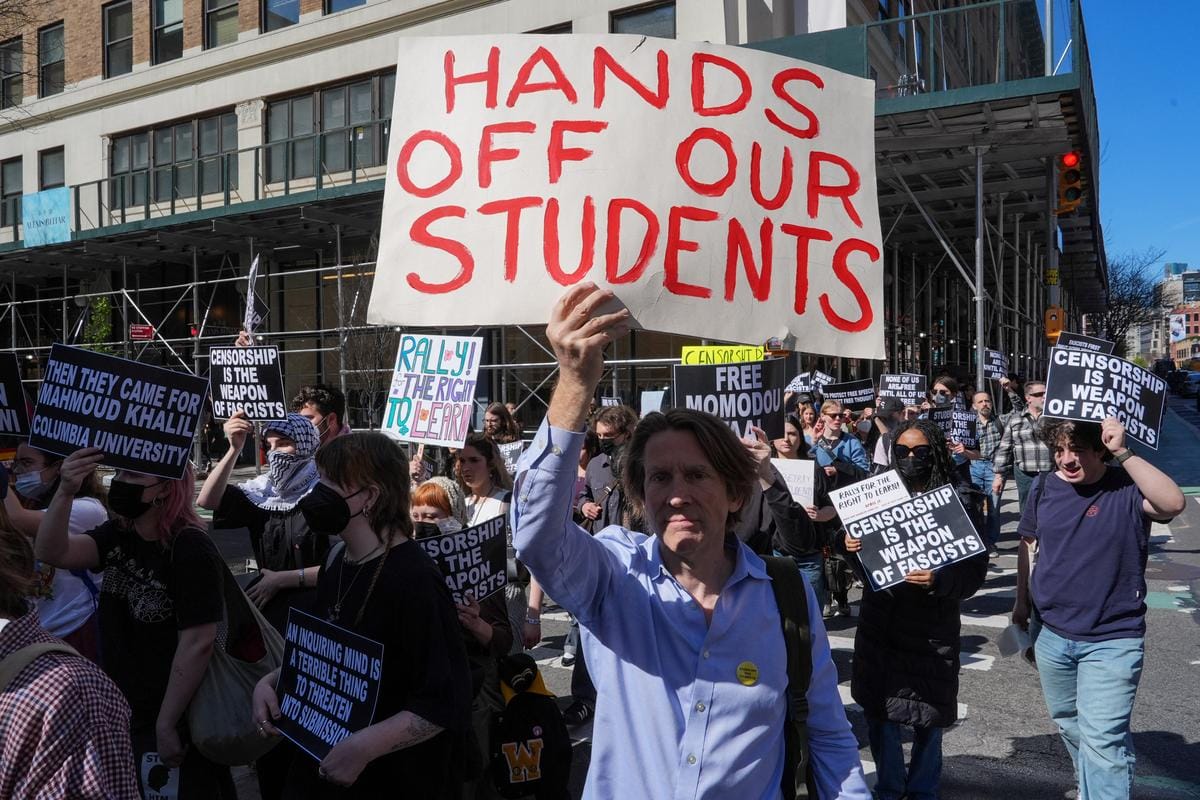*Based on Noam Chomsky’s Requiem For The American Dream
In the new India, the rights of citizens who do not follow the majoritarian ideology are getting curbed daily. Even though democracy has always remained an ideal, many democratic practices have ceased to exist in today’s India. The ideas that the country was founded on are dwindling under the current regime. Noam Chomsky wrote Requiem for the American Dream: The 10 Principles of Concentration of Wealth and Power to highlight the deep-rooted problems in American democracy.
He emphasised the influence of the privileged and the powerful on governance and how it leads to a vicious cycle of concentration of power and concentration of wealth between the two, feeding off each other. With increasing privatisation and civil unrest in India, we see how a similar phenomenon plagues Indian society today.
Especially with the introduction of the new farm laws, which the farmers are vehemently opposing citing that it only will benefit the capitalists, it becomes imperative to understand how the concentration of power and concentration of wealth is working in this democracy. Wealth inequality has risen exponentially since India’s liberalisation. During the Covid-19 pandemic, India saw a sharp rise in capitalists’ wealth when the rest of the country is struggling with inflation and no jobs.
Also read: Capitalism And Colonisation: How The Climate Change Movement Is Being Whitewashed

Chomsky’s ten principles give a good insight into the process of this concentration and how we reached here. Through this comparative analysis, we understand what development is and how it works in a democracy to only cater to a few. These principles also glance at the direction we are moving towards and would hopefully make us critically analyse the society we currently find ourselves in.
Noam Chomsky wrote Requiem for the American Dream to show how power and wealth distribution are interlinked in America.
Even though this has been happening in India for quite some time now, it is essential to analyse how it is crucial in the current times with increasing privatisation and faltering democracy.
An unforgettable part of any middle-class dream is class mobility: You are born poor, work hard, and get rich. However, this dream is only available to a few. The rest of the population is robbed from dreaming, only trying to survive by fulfilling its basic needs. Somehow, this has become acceptable.
Chomsky says the concentration of wealth yields concentration of power, particularly so as the cost of elections skyrockets, which forces the political parties even more deeply into major corporations’ pockets. This political power quickly translates into legislation that increases the concentration of wealth, creating a vicious cycle.
Also read: Un-Fair And Not So Lovely: Capitalism And Colourism In India
Principle #1: Reduce Democracy
The privileged and the powerful sectors never liked democracy because it takes power away from them and puts it in the hand of the general population. To keep the power intact, they decided that democracy should be reduced. The structure of the system was hence designed to prevent the danger of democracy and to organise the system so that power would be in the hands of the wealthy and also, to fragment the population in many ways so that they couldn’t get together to organise to take away the power of the rich.

India ranks 53rd in the 2019 Democracy Index, slipping from 27th (in 2014) to 53rd due to democratic backsliding under the current regime.
Principle #2: Shaping Ideology

The people in power thought the young people were getting too free and independent and were beginning to organise and enter the political arena. They said that imposes too much pressure on the system, and hence the young need to be depoliticised. This was a failure on the part of the schools, the universities, the religious institutions responsible for the ‘indoctrination of the young.’ They offered measures to reinstitute better indoctrination to control the press, drive people back into passivity and apathy, and let the ‘right’ kind of society develop.
Also read: Marketing The Rainbow: Queer Advertising Campaigns In India
Principle #3: Redesigning The Economy

While the poor and economically disadvantaged desperately need to be shown solidarity, it is of no use to the ‘masters’ who try very hard to destroy it.
The policy is designed to increase insecurity. Keeping workers insecure is going to make them be under control. They will not ask for decent wages or decent working conditions, benefits or the opportunity to unionise. If workers are kept insecure, they are not going to ask for too much. They will be delighted— they will not even care if they have to have rotten jobs, they will not ask for benefits—and by some theory, that is considered a healthy economy. Furthermore, another tactic is by keeping the working hours high, which means less freedom, less time for leisure, less time for thought, more following orders, etc.
Principle #4: Shift The Burden

The tax system has been redesigned so that the very wealthy’s taxes are reduced and, correspondingly, the tax burden on the rest of the population’s increased. The shift is towards trying to keep taxes just on wages and consumption with the pretext that it will increase investment and increase jobs, but there is no evidence. It is just a way for the major corporations to shift the burden of sustaining society onto the rest of the population.
Principle #5: Attack Solidarity

Solidarity is ‘caring for others’. The rich and powerful have tried hard to drive compassion out of people’s heads. We see it a lot in policy formation. While the poor and economically disadvantaged desperately need to be shown solidarity, it is of no use to the ‘masters’ who try very hard to destroy it. There is a way to destroy such policies, and that is by defunding them. Do you want to destroy some system? First, defund it. Then, it will not work. People will be angry, and they will want something else. It is a standard technique for privatising that system and hence making it exclusionary.
Also read: Analysis: The Social Inequities That COVID-19 Pandemic Exacerbated
Principle #6: Run The Regulators

For advertisers, the aim is to create uninformed consumers who will make irrational choices. Elections running with the same PR systems want to create an uninformed electorate that will often make irrational choices against their interest.
The business being regulated is, in fact running the regulators. One is a legislator and becomes a lobbyist, and as a lobbyist, they want to control legislation. The corporates and corporate lobbyists are writing the laws of financial regulation, which often leads to a crisis. Each time, the taxpayer is called on to bail out those who created the crisis, increasingly the major financial institutions. If you let people who led to the crisis make economic policies, then what do you expect?
Principle #7: Engineer Elections

The cost of election skyrockets and parties go into the pocket of corporate power. When money is declared a form of speech, it means that corporations, which have been pretty much-buying elections, are now free to do it with virtually no constraint. Thomas Ferguson, the political scientist, has developed what he calls “the investment theory of politics,” implying that business and investors, not the voters, have tremendous influence in the political system. That is a massive attack on the residue of democracy.
Principle #8: Keep The Rabble In Line

With all its flaws, organised labour is the one organised democratising force and barrier to corporate tyranny. They provide a barrier that defends workers’ rights, but also popular rights generally. If someone is in power and privilege, one wants to maintain class-consciousness but eliminate it everywhere else; do not want them to know they are the oppressed class. The whole rhetorical system has shifted around to prevent people from seeing what is happening, precisely what one would expect people with power to do.
Also read: ‘Nationalism Revisited’: In The Personal Interest Of The Right-Wing Regime
Principle #9: Manufacture Consent

Power is in the hands of the governed. Moreover, if they understand that, then repressive and authoritarian governments alike will collapse. That is one of the reasons why we have this enormous public relations industry. Bernays, the PR industry founder, in his book Propaganda, mentioned that the general public is too dumb to understand what is best for them, so we will engineer their consent to what we decide. For advertisers, the aim is to create uninformed consumers who will make irrational choices. Elections running with the same PR systems want to create an uninformed electorate that will often make irrational choices against their interest. They are to be spectators, not participants. That is how one gets a ‘properly functioning democracy’.
Principle #10: Marginalise The Population

70% of the population has no way of influencing policy, and they might as well be in some other country. This has led to a frustrated population whose unfocused anger has taken on the form of attacks on one another and vulnerable targets. The point is to make people hate each other, look out only for themselves, and not do anything for anyone else.
Bhawna is a design researcher and an artist trying to work at the intersections of design, art, and social justice. She spends most of her time obsessing over something or the other, engrossed in a good book or just daydreaming about scenarios that are too crazy for our sane world. You can find her on Instagram.
All images as provided by the author, Bhawna Parmar.




